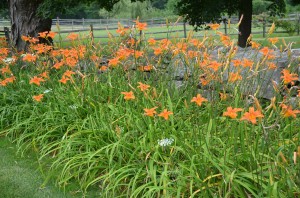A native of eastern Asia, tawny daylilies (Hemerocallis fulva) are often called “ditch lilies”. You see them growing along roadsides, in back alleys, and in old gardens, often in very poor soil. Their tenacious root system helps to stabilize steep slopes. They seem to thrive in places too difficult for most plants. They’re grow so easily that they eventuallyspread and become a nuisance.
They start blooming in late June in USDA zones 6 and 7. The 4 ½ inch diameter pale orange flowers are borne on sturdy 5- 6 foot tall floral scapes. Flowers last one day, and each scape bears multiple floral buds which open over a 3-5 week period. They come in a rainbow of flower colors, but orange is the most common. Some H. fulva cultivars are sterile and are less of a potential nuisance.
Ditch lilies prefer full or partial sun. In the lower South (USDA zones 7-b thru 9), ditch lilies are best sheltered from direct sunlight. Soils should be moist, loamy, slightly acidic, and well-drained. Fertilize with 10-10-10 or equivalent in early spring when new growth starts up and again in midsummer.
Ditch lilies form large thick clumps of arching, strap-like bright green leaves. Established clumps cope with summer heat and drought spells. Ditch lilies will grow in semi-shade, but produce more foliage and less flowers.
Group ditch lilies together in the wide border to naturalize. Because of their invasive tendencies, ditch lilies are ideal for planting in confined spaces such as in parking lot islands or in median strips on a busy highway.
They have few problems with pests and foliar diseases. Clumps spread quickly and should be dug up and divided every 4-5 years in early autumn. Occasionally, flower scapes develop aerial plant/root proliferations which can be easily rooted.


 Posted in
Posted in 
